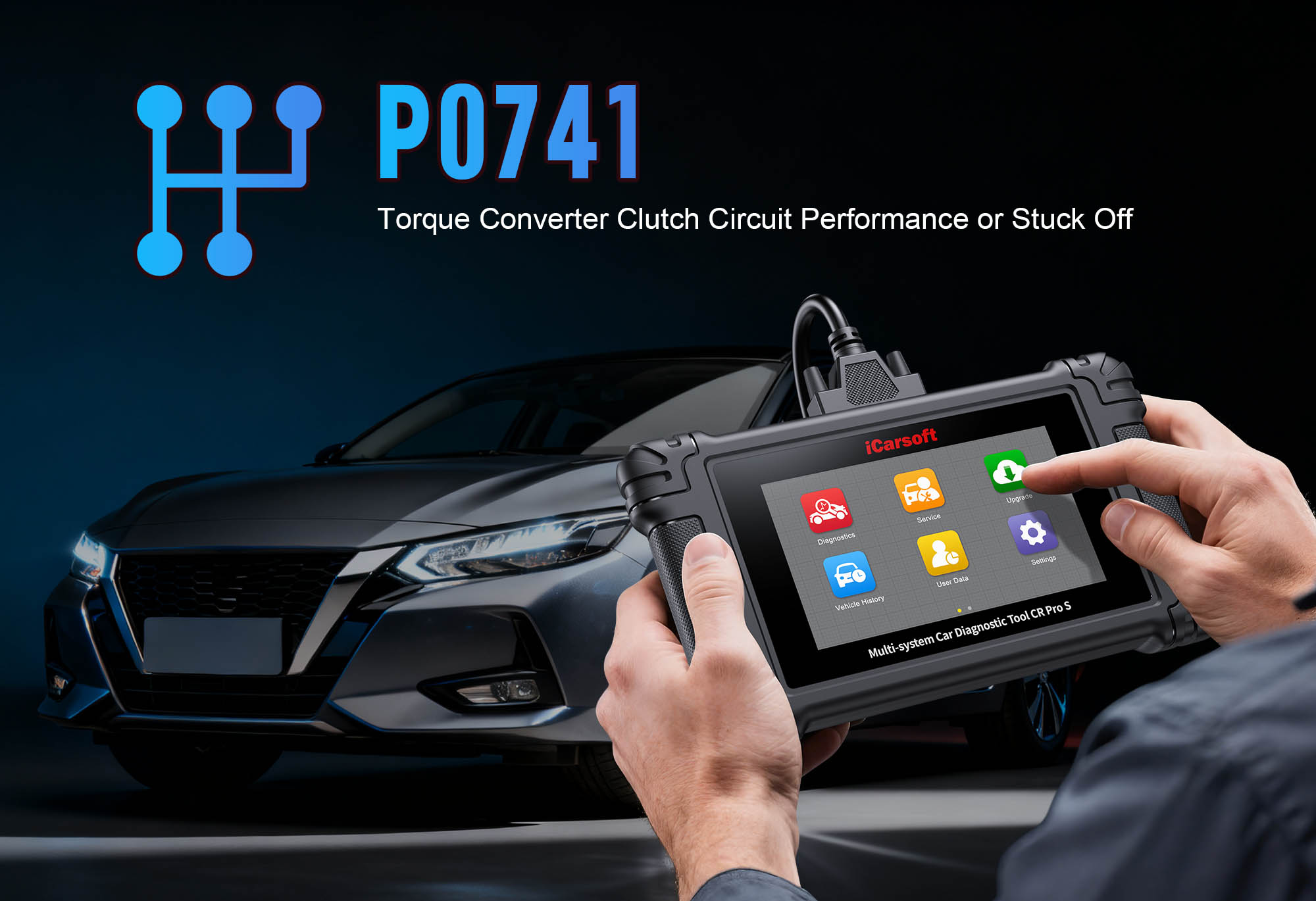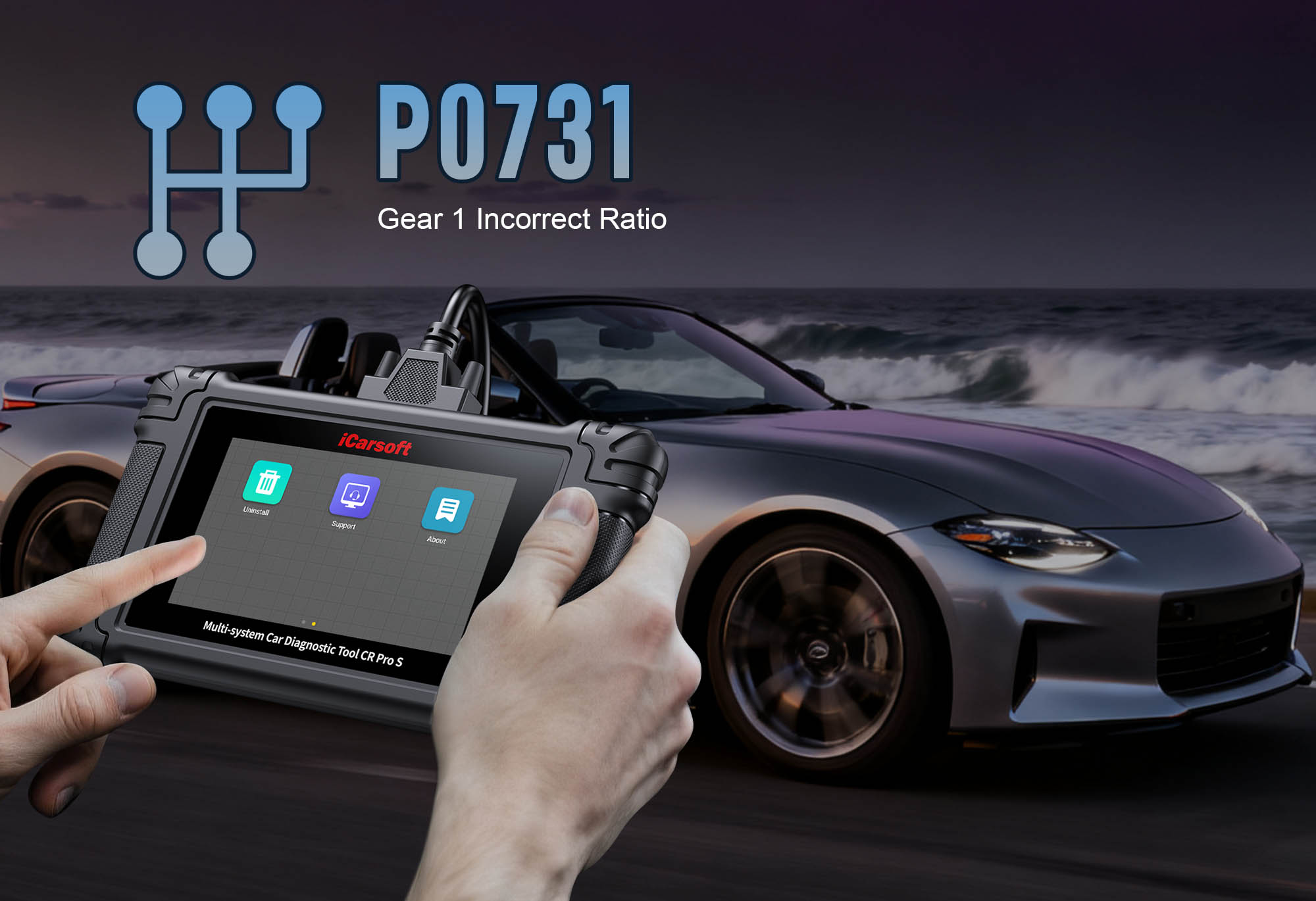P0741 Code: Diagnose & Clear Torque Converter Clutch Circuit Performance with iCarsoft CR Pro S
If your check engine light turns on and you notice symptoms like transmission slipping, reduced fuel efficiency, or a "shudder" during highway acceleration, a diagnostic scan will likely return P0741. This OBD-II code stands for "Torque Converter Clutch (TCC) Circuit Performance," indicating the Transmission Control Module (TCM) is struggling to engage or maintain the torque converter clutch—a critical component that connects the engine to the transmission for efficient power transfer.
The torque converter clutch eliminates "slip" between the engine and transmission at cruising speeds (typically 40+ mph), boosting fuel efficiency by up to 10% and reducing transmission heat. The TCM controls the clutch via a solenoid, monitoring its engagement through input/output speed sensors. P0741 triggers when the TCM detects the clutch isn’t engaging properly (e.g., delayed engagement, partial slip, or no engagement at all)—often due to electrical faults (solenoid/wiring) or mechanical issues (clutch wear, low fluid). Left unaddressed, it can lead to transmission overheating, premature clutch failure, or costly rebuilds.
Basic scanners may only flag "TCC circuit fault" but can’t test clutch engagement or distinguish between electrical and mechanical causes. The iCarsoft CR Pro S, with its bi-directional TCC control, live transmission data analysis, and global vehicle coverage, solves this. Let’s walk through how to diagnose and resolve P0741 with precision.
Understanding P0741: Causes & Key Symptoms
A malfunctioning TCC disrupts efficient power transfer, with symptoms that worsen during steady-speed driving (when the clutch should be engaged)—these clues help narrow down electrical vs. mechanical causes.
Key Symptoms of P0741
-
Transmission Shudder: A vibration or "judder" when accelerating to 40–60 mph, as the TCC tries and fails to engage smoothly.
-
Reduced Fuel Efficiency: Without proper TCC engagement, the transmission slips—expect 5–15% lower MPG, especially on highways.
-
Delayed or No Overdrive: The transmission may refuse to shift into overdrive, limiting highway speed and keeping engine RPM unnecessarily high.
-
Transmission Overheating: Slip from a faulty TCC generates excess heat—look for a "Transmission Hot" warning or burnt-smelling fluid.
-
Limp Mode Activation: Severe cases trigger limp mode, locking the transmission in 2nd/3rd gear to prevent damage and restricting speed to 30–40 mph.
-
Slipping Between Gears: The engine revs higher than normal during acceleration, but vehicle speed increases slowly (sign of TCC not holding).
Common Causes of P0741
|
Cause
|
Description
|
|
Faulty TCC Solenoid
|
Electrical burnout or mechanical sticking prevents the solenoid from controlling TCC engagement—the most common cause of P0741.
|
|
Low/Degraded Transmission Fluid
|
Insufficient fluid pressure stops TCC engagement; old, dirty fluid clogs the solenoid or valve body passages.
|
|
Wiring/Circuit Issues
|
Corroded connectors, frayed wires, or short circuits disrupt signal flow between the TCM and TCC solenoid.
|
|
Worn TCC Clutch
|
Friction material on the clutch wears thin (common in high-mileage vehicles), preventing full engagement.
|
|
TCM Malfunction
|
Outdated firmware or internal faults cause the TCM to send incorrect signals to the TCC solenoid (rare but impactful).
|
|
Clogged Valve Body
|
Debris blocks the valve that controls TCC fluid flow, limiting pressure and preventing proper engagement.
|
Why iCarsoft CR Pro S Excels at Diagnosing P0741
The CR Pro S outperforms basic tools with TCC-specific features, critical for isolating electrical (solenoid/wiring) vs. mechanical (clutch/valve body) causes of P0741:
Bi-Directional TCC Control
Manually commands TCC engagement/disengagement to test if the clutch responds—eliminates guesswork about solenoid function.
Live TCC Slip Analysis
Calculates input/output speed slip in real time (e.g., "5% slip = normal; 15% slip = faulty TCC") to quantify engagement issues.
Global Vehicle Coverage
Works with 500+ models (Mercedes-Benz, BMW, Toyota, Ford) plus niche brands (Maserati, Volvo) for TCC systems that vary by make.
Transmission Fluid Checks
Guides fluid level/quality inspection and includes battery voltage tests (low voltage disrupts TCC solenoid operation).
TCM Firmware Updates
Offers free lifetime updates to fix P0741 false triggers from outdated TCM software (common in 2018+ vehicles).
Solenoid Actuation Tests
Activates the TCC solenoid directly to verify wiring integrity—distinguishes between solenoid faults and TCM issues.
Step-by-Step: Diagnose P0741 with iCarsoft CR Pro S
-
Check Transmission Fluid Level & Quality First
1. Park on level ground, start the engine, and let it reach operating temperature (5–10 minutes).
2. Locate the transmission dipstick (use CR Pro S’s Component Location tool) or access port (sealed transmissions).
3. Fluid Level: For dipstick models, ensure fluid is between "MIN" and "MAX." For sealed units, use Transmission Fluid Temperature (TFT) Readout (175–200°F = operating temp) then check via fill port.
4. Fluid Quality: Healthy fluid = bright red, odorless. Dark brown/black + burnt smell = degraded (needs replacement + filter service).
-
Connect the CR Pro S & Confirm the Code
1. Plug the CR Pro S into the OBD-II port (use OBDI adaptors for older models: Mercedes 38Pin, BMW 20Pin).
2. Select your vehicle via Auto VIN Identify (instant specs) or manual entry.
3. Navigate to Transmission > Fault Codes > Read Codes to confirm P0741. Tap Code Details for vehicle-specific tips (e.g., "Toyota Camry: Check TCC Solenoid on Valve Body").
-
Locate the TCC Solenoid & Related Components
1. Go to Component Location > Transmission > Solenoids > Torque Converter Clutch (TCC) Solenoid.
2. Use the diagram to identify key parts:
- TCC Solenoid: On transmission valve body (inside pan or side of case) with 2–3 pin connector.
- Wiring Harness: Path to TCM (check for damage near exhaust/moving parts).
- Input/Output Speed Sensors: Monitor TCC slip (critical for data analysis).
- Transmission Pan: Access point for valve body/solenoid inspection (if needed).
-
Analyze Live TCC & Transmission Data
1. Start the engine, shift to Drive, and accelerate to 50 mph (cruise speed).
2. Navigate to Transmission > Live Data > Torque Converter and monitor:
- TCC Engagement Status: Should show "Engaged" at 40+ mph. "Disengaged/Partial" = P0741 trigger.
- Input/Output Speed Slip: Normal = <5% slip (2,000 RPM input → 1,950 RPM output). >10% = faulty TCC.
- TCC Solenoid Voltage: 12V when engaged. 0V = no power; erratic = TCM issue.
- Fluid Temperature: Keep <220°F. Over 240°F = stop driving (prevents damage).
-
Test TCC Function with Bi-Directional Control
1. Bi-Directional Engagement: - Idle engine (parking brake on). Go to Special Functions > Transmission > Actuation Tests > TCC Solenoid Control.
- Set TCC to 50% (partial) then 100% (full) engagement:
- RPM Drop: Full engagement = 100–200 RPM lower (800 → 650 RPM). No drop = solenoid/clutch fault.
- Solenoid Click: Listen for a faint "click" (confirms power). No click = burnout/wiring issue.
2. Solenoid Resistance Test: - Turn off engine, disconnect solenoid connector. Use CR Pro S’s Multimeter Function: Normal = 10–30 ohms. Infinite = open circuit; <5 ohms = short.
-
Inspect Wiring, Connectors, & Valve Body
1. Wiring/Circuit Check: - Use Circuit Continuity Test between solenoid and TCM (normal = <5 ohms). High resistance = frayed wire; 0 ohms = short.
2. Connector Cleaning: - Clean corroded terminals with electrical contact cleaner (check for water intrusion).
3. Valve Body Inspection: - If fluid is dirty, remove transmission pan (use Torque Guide for bolts) and clean TCC fluid passages with a soft brush.
-
Rule Out TCM or Mechanical Clutch Issues
1. TCM Firmware Update: - Go to System > Update Manager to install free updates (fixes miscalculated TCC timing).
2. Mechanical Clutch Wear Check: - For vehicles >100,000 miles, use CR Pro S’s Transmission Health Report to flag long-term slip (sign of worn clutch). Professional rebuild/replacement needed if confirmed.
-
Repair & Clear P0741
1. Fix the root cause:
- Fluid Issues: Drain/replace fluid + filter (use Service Guide for type/capacity).
- Solenoid Fault: Replace with OEM part (use Part Lookup).
- Wiring/Circuit: Splice wires, repair shorts, or replace connectors.
- TCM: Install firmware updates or repair/replace module.
- Clutch Wear: Have a technician rebuild the torque converter.
2. Clear the code: Navigate to Transmission > Fault Codes > Clear Codes to delete P0741.
-
Validate the Repair
1. Recheck live data: TCC engages at 40+ mph with <5% slip; solenoid voltage = steady 12V.
2. Test drive 30–40 minutes (include highway cruising): No shudder, slipping, or warning lights.
3. Post-drive scan: Use Transmission System Scan after 50 miles to confirm P0741 doesn’t return.
Preventing P0741 Recurrence
Use the iCarsoft CR Pro S to maintain TCC and transmission health long-term:
-
Fluid Maintenance: Set Service Reminder to replace transmission fluid every 60,000 miles (40,000 miles for towing/stop-and-go driving).
-
TCC System Checks: Include TCC solenoid resistance/engagement tests in annual scans—catch early faults before P0741 triggers.
-
Firmware Updates: Enable Update Alerts to install TCM updates that improve TCC performance (critical for 2015+ vehicles).
-
Driving Habits: Avoid revving in Park/Neutral (reduces TCC wear) and use cruise control on highways (minimizes slip).
Conclusion
P0741’s TCC issue doesn’t just hurt fuel efficiency—it threatens transmission longevity. The iCarsoft CR Pro S simplifies diagnosis with bi-directional control, live slip analysis, and global coverage, ensuring you fix the root cause (not just replace parts blindly).
Whether updating the TCM, replacing a solenoid, or servicing fluid, this tool turns complex TCC diagnostics into a manageable process. With the CR Pro S, you’ll restore smooth engagement, boost MPG, and keep your transmission running reliably for miles.
FAQs About P0741 Code
Q: Can I drive with P0741?
A: Short trips are possible, but prolonged driving causes transmission overheating. If you notice shudder or overheating, limit driving and address P0741 within 1–2 weeks.
Q: How much does it cost to fix P0741?
A: $80–$200 for an OEM TCC solenoid; $100–$300 for fluid/filter service; $300–$800 for torque converter rebuild (plus labor). TCM repairs cost $400–$1,000. The CR Pro S ($300–$400) saves by avoiding unnecessary parts replacement.
Q: Will changing transmission fluid fix P0741?
A: Only if dirty/low fluid is clogging the TCC solenoid or valve body. Use the CR Pro S to test solenoid function—if the solenoid is faulty, fluid replacement alone won’t resolve P0741.
Q: Is P0741 a serious code?
A: Yes—ignoring it leads to transmission overheating and clutch failure, which can cost $2,000+ for a full rebuild. Address P0741 promptly to avoid major damage.





